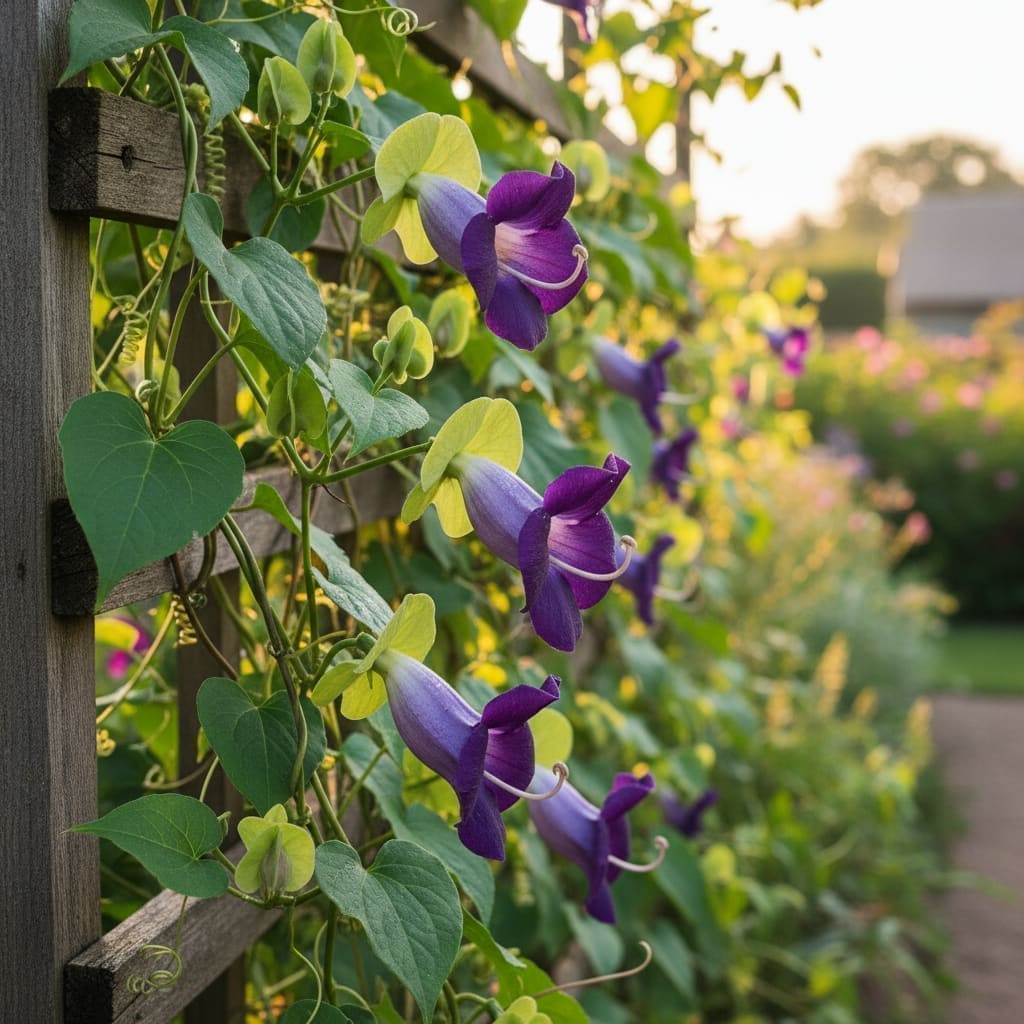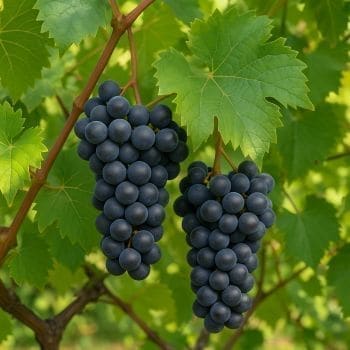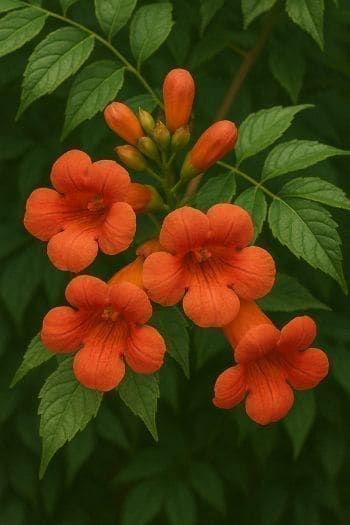Cobaea scandens (Cathedral Bells) Plant Care & Growing Guide
Overview
Cobaea scandens, commonly known as cathedral bells or cup-and-saucer vine, is a fast-growing, perennial climber native to Mexico. It is admired for its large, bell-shaped flowers that can range from greenish-white to deep purple as they mature. In warm climates, it can be grown as a perennial; in cooler regions, it is often cultivated as an annual. Its vigorous growth and striking blooms make it a popular choice for covering trellises, fences, and pergolas.
This plant belongs to the phlox family (Polemoniaceae) and is known for its ability to quickly cover structures with lush foliage and abundant flowers during the growing season.
Identification & Growth Habit
Cobaea scandens is a trailing and climbing vine that can reach lengths of 20 feet (6 meters) or more in a single season under ideal conditions. It climbs using tendrils that spring from the leaf stems, allowing it to cling to supports. The leaves are compound, with two to three pairs of leaflets and a terminal tendril. Flowers are large, bell-shaped, and borne singly on long stalks, starting green and gradually turning purple or violet as they mature.
Light & Placement
This plant thrives in bright, direct sunlight for at least 6–8 hours daily. Outdoors, position it in a sunny spot with some afternoon shade in very hot climates to prevent leaf scorch. Indoors, place near a south-facing window or in a sunroom. Lack of sufficient light can lead to poor flowering and leggy growth.
Watering & Humidity
During the active growing season (spring through early autumn), keep the soil consistently moist but not waterlogged. Water when the top inch of soil feels dry to the touch. In winter or during dormancy, reduce watering significantly, especially if grown indoors under cooler conditions.
Cobaea scandens prefers moderate to high humidity. In dry indoor environments, increase humidity by using a humidifier, grouping plants together, or placing a water-filled pebble tray nearby.
Soil & Repotting
Use a well-draining soil enriched with organic matter. A good mix is two parts high-quality potting soil, one part compost, and one part perlite or coarse sand for aeration. This helps prevent root rot and supports vigorous growth.
When grown in containers, repot annually in early spring before new growth begins. Choose a pot with adequate drainage holes to prevent water accumulation.
Fertilizing
Feed sparingly to encourage flowering over excessive vine growth. Apply a balanced liquid fertilizer (e.g., 10-10-10) once a month during the growing season. In mid-summer, side-dress with compost to replenish nutrients. Avoid high-nitrogen fertilizers, which can promote foliage at the expense of blooms.
Pruning & Training
Pruning is essential to manage size and encourage branching. Pinch back young shoots to promote bushier growth. Remove dead or damaged stems as needed. Since Cobaea scandens is a climber, provide sturdy support such as a trellis, arbor, or moss pole. Train vines by gently tying them to the support structure until tendrils take hold.
Propagation
From Seeds
- Sow seeds indoors 6–8 weeks before the last expected frost date or directly outdoors after frost danger has passed.
- Soak seeds overnight to soften the seed coat and improve germination.
- Plant seeds on their side about 1/4 inch (6 mm) deep in moist, well-draining seed-starting mix.
- Maintain a temperature of 65–70°F (18–21°C) and keep the medium consistently moist.
- Germination typically occurs in 2–4 weeks.
From Stem Cuttings
- Take 4–6 inch (10–15 cm) stem cuttings from healthy, non-flowering shoots in spring or early summer.
- Remove the lower leaves, leaving two or three at the top.
- Dip the cut end in rooting hormone to encourage root development.
- Plant in a small pot filled with well-draining soil mix.
- Keep in bright, indirect light and maintain consistent moisture until roots form (usually 3–4 weeks).
Common Problems
Pests
- Aphids: Small, sap-sucking insects that cluster on new growth. Control with insecticidal soap or a strong water spray.
- Spider mites: Tiny pests causing stippling and webbing. Increase humidity and treat with miticide if necessary.
- Whiteflies: Small flying insects; use yellow sticky traps and insecticidal soap.
Diseases
- Powdery mildew: White, powdery coating on leaves; improve air circulation and treat with fungicide if needed.
- Root rot: Caused by overwatering or poor drainage; prevent by using well-draining soil and proper watering practices.
Toxicity & Pet Safety
Cobaea scandens is considered toxic if ingested by humans or pets. Keep out of reach of children, cats, dogs, and other animals. Wear gloves when handling if you have sensitive skin.
Styling & Decor Tips
Use Cobaea scandens to create a lush, vertical accent in gardens or patios. It is ideal for covering unsightly fences, adding a romantic touch to pergolas, or framing an entryway. In containers, pair with trailing plants for a cascading effect. Its large, bell-shaped blooms make it a conversation piece in any setting.
Varieties & Cultivars
- Cobaea scandens var. alba: Features white flowers instead of the typical purple.
- Cobaea scandens ‘Purple’: The most common form, with deep violet blooms.
Buying Tips & Maturity
When purchasing, look for healthy plants with vigorous stems and no signs of pests or disease. If buying seeds, choose fresh stock from reputable suppliers for better germination rates. Cobaea scandens grows rapidly, often reaching maturity and flowering within the first growing season when started early.
Seasonal Care
- Spring: Start seeds indoors or plant outdoors after frost. Provide support structures early.
- Summer: Maintain regular watering and monthly feeding. Train vines and prune as needed.
- Autumn: In frost-prone areas, collect seeds for next year or take cuttings to overwinter indoors.
- Winter: In warm climates, prune lightly and reduce watering. In cold climates, the plant may die back; treat as an annual or overwinter indoors in a bright, cool location.
FAQ
- How fast does Cobaea scandens grow? Under ideal conditions, it can grow several feet per month during the peak season.
- Can it be grown indoors year-round? Yes, if provided with ample light, warmth, and humidity, though flowering may be reduced indoors.
- When does it bloom? Typically from midsummer to early autumn, depending on planting time and climate.
- Is it frost-hardy? No, it is sensitive to frost and should be protected or treated as an annual in cold climates.
- Do I need to deadhead the flowers? Deadheading can encourage more blooms, but is not strictly necessary.
Sources: Wikipedia, The Spruce






